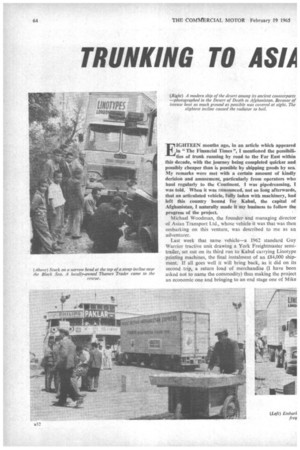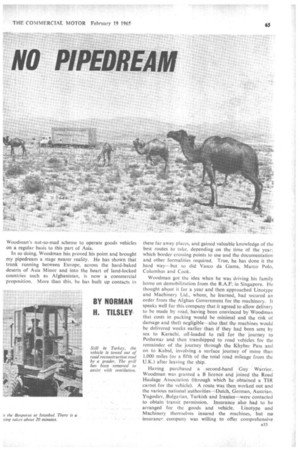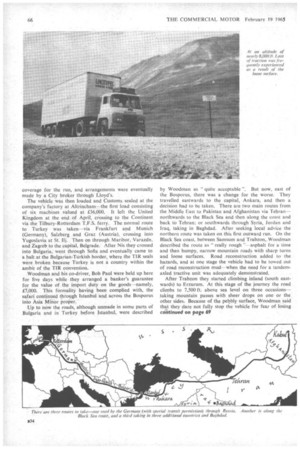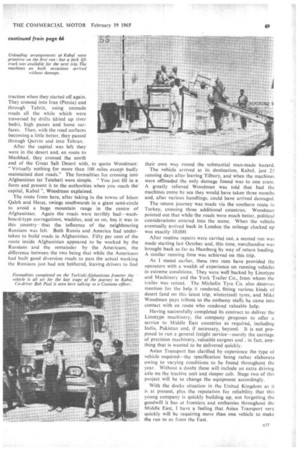TRUNKING TO ASIA NO PIPEDIREAM
Page 66

Page 67

Page 68

Page 71

If you've noticed an error in this article please click here to report it so we can fix it.
IGHTEEN months ago, in an article which appeared in "The Financial Times", I mentioned the possibilities of trunk running by road to the Far East within this decade, with the journey being completed quicker and possibly cheaper than is possible by shipping goods by sea. My remarks were met with a certain amount of kindly derision and amusement, particularly from operators who haul regularly to the Continent. I was pipedreaming, I was told. When it was announced, not so long afterwards, that an articulated vehicle, fully laden with machinery, had left this country bound for Kabul, the capital of Afghanistan, I naturally made it my business to follow the progress of the project.
Michael Woodman, the founder and managing director of Asian Transport Ltd., whose vehicle it was that was then embarking on this venture, was described to me as an adventurer.
Last week that same vehicle—a 1962 standard Guy Warrior tractive unit drawing a York Freightmaster semitrailer, set out on its third run to Kabul carrying Linotype printing machines, the final instalment of an £84,000 shipment. If all goes well it will bring back, as it did on its second trip, a return load of merchandise (I have been asked not to name the commodity) thus making the project an economic one and bringing to an end stage one of Mike
Woodman's not-so-mad scheme to operate goods vehicles on a regular basis to this part of Asia.
In so doing, Woodman has proved his point and brought my pipedream a stage nearer reality. He has shown that trunk running between Europe, across the hard-baked deserts of Asia Minor and into the heart of land-locked countries such as Afghanistan, is now a commercial proposition. More than this, he has built up contacts in
these far away places, and gained valuable knowledge of the best routes to take, depending on the time of the year: which border crossing points to use and the documentation and other formalities required. True, he has done it the hard way—but so did Vasco da Gama, Marco Polo, Columbus and Cook.
Woodman got the idea when he was driving his family home on demobilization from the R.A.F. in Singapore. He thought about it for a year and then approached Linotype and Machinery Ltd., whom, he learned, had secured an order from the Afghan Government for the machinery. It speaks well for this company that it agreed to allow delivery to be made by road, having been convinced by Woodman that costs in packing would be minimal and the risk of damage and theft negligible—also that the machines would be delivered weeks earlier than if they had been sent by sea to Karachi, off-loaded to rail for the journey to Peshawar and then transhipped to road vehicles for the remainder of the journey through the Khyber Pass and on to Kabul, involving a surface journey of more than 1,000 miles (or a fifth of the total 'road mileage from the U.K.) after leaving the ship.
Having purchased a ", second-hand 'Guy Warrior.
Woodman was granted a B licence and joined the Road Haulage Association (through which he .obtained a T1R carnet for the vehicle). A route was then worked out and the various nationalauthorities—Dutch, German, Austrian,
Yugoslav, Bulgarian, Turkish and Iranian—were contacted 1 to obtain transit permission. Insurance also had to be arranged for the goods and vehicle. Linotype and Machinery themselves insured• the machines, but no insurance' company was willing to offer comprehensive e33 coverage for the run, and arrangements were eventually made by a City broker through Lloyd's.
The vehicle was then loaded and Customs sealed at the company's factory at Altrincham—the first load consisting of six machines valued at £36,000. It left the United Kingdom at the end of April, crossing to the Continent via the Tilbury-Rotterdam T.F.S. ferry. The normal route to Turkey was taken—via Frankfurt and Munich (Germany), Salzberg and Graz (Austria), crossing into Yugoslavia at St. Ilj. Then on through Maribor, Varazdn, and Zagreb to the capital, Belgrade. After Nis they crossed into Bulgaria, went through Sofia and eventually came to a halt at the Bulgarian-Turkish border, where the TIR seals were broken because Turkey is not a country within the ambit of the TIR convention.
Woodman and his co-driver, Bob Paul Were held up here for five days while they arranged a banker's guarantee for the value of the import duty on the goods—namely, £7,000. This formality having been complied with, the safari continued through Istanbul and across the Bosporus into Asia Minor proper.
Up to now the roads, although unmade in some parts of Bulgaria and in Turkey before Istanbul, were described by Woodman as " quite acceptable ". But now, east of the Bosporus, there was a change for the worse. They travelled eastwards to the capital, Ankara, and then a decision had to be taken, There are two main routes from the Middle East to Pakistan and Afghanistan via Tehran— northwards to the Black Sea and then along the coast and back to Tehran; or southwards through Syria, Jordan and Iraq, taking in Baghdad. After seeking local advice the northern route was taken on this first outward run. On the Black Sea coast, between Samsum and Trabzon, .Woodman described the route as "really rough ". -asphalt for a time and then bumpy, narrow mountain roads with sharp turns and loose surfaces. Road .reconstruction added to the hazards, and at one stage the vehicle had to be towed out of road reconstruction mud—when the need for a tandemwded tractive unit was adequately demonstrated.
After Trabzon they started climbing inland (south eastwards) to Erzurum. At this stage of the journey the road climbs to 7,500 ft. above sea level on three occasions— taking mountain passes with sheer drops on one or the other sides. Because of the pebbly surface, Woodman said that they dare not fully stop the vehicle for fear of losing continued on page 69 traction when they.started off again. They crossed into Iran (Persia) and through Tabriz, using unmade roads all the while which were traversed by drifts (dried up river beds), high passes and loose surfaces. Then, with the road surfaces becoming a little better, they passed through Qazvin and into Tehran.
After the capital was left they were in the desert and, en route to Mashhad, they crossed the north end of the Great Salt Desert with, to quote Woodman: "Virtually nothing for more than 100 miles except badly maintained dust roads." The formalities for crossing into Afghanistan (at Tatebat) were simple. "You just fill in a form and present it to the authorities when you reach the capital, Kabul ", Woodman explained.
The route from here, after taking in the towns of Islam Qaleh and Herat, swings southwards in a giant semi-circle to avoid a huge mountain range in the centre of Afghanistan. Again the roads were terribly bad—washboard-type corrugations, waddies, and so on, but it was in this country that the influence of the neighbouring Russians was felt. Both Russia and America had undertaken to build roads in Afghanistan. Fifty per cent of the route inside Afghanistan appeared to be worked by the Russians and the remainder by the Americans, the difference between the two being that while the Americans had built good diversion roads to pass the actual working the Russians just had not bothered, leaving drivers to find their own way round the substantial man-made hazard.
The vehicle arrived at its destination, Kabul, just 25 running days after leaving Tilbury, and when the machines were offloaded the only damage found was to one crate. A greatly relieved Woodman was told that had the machines come by sea they would have taken three months and, after various handlings, could have arrived damaged.
The return journey was made via the southern route in Turkey, crossing three additional countries. Woodman pointed out that while the roads were much better, political considerations entered into the scene. When the vehicle eventually arrived back in London the mileage clocked up was exactly 10,000.
After routine repairs were carried out, a second run was made starting last October and, this time, merchandise was brought back as far as Hamburg by way of return loading. A similar running time was achieved on this trip.
As I stated earlier, these two runs have provided the operators with a wealth of experience on running vehicles in extreme conditions. They were well backed by Linotype and Machinery and the York Trailer Co., from whom the trailer was rented. The Michelin Tyre Co. also deserves mention for the help it rendered, fitting various kinds of desert (and on this latest trip, winterized) tyres, and Mike Woodman pays tribute to the embassy staffs he came into contact with en route who rendered valuable help.
Having successfully completed its contract to deliver the Linotype machinery, the company proposes to offer a service to Middle East countries as required, including India, Pakistan and, if necessary, beyond. It is not proposed to run a general freight service—merely the carriage of precision machinery, valuable cargoes and , in fact, anything that is wanted to be delivered quickly.
Asian Transport has clarified by experience the type of vehicle required—the specification being rather elaborats owing to varying conditions to be found throughout the year. Without a doubt these will include an extra driving axle on the tractive unit and sleeper cab. Stage two of this project will be to change the equipment accordingly,
With the docks situation in the United Kingdom as it is at present, plus the reputation for reliability that this young company is quickly building up, not forgetting the goodwill it has at frontiers and embassies throughout the Middle East, I have a feeling that Asian Transport very quickly will be requiring more than one vehicle to make the run to or from the East.




































































































































